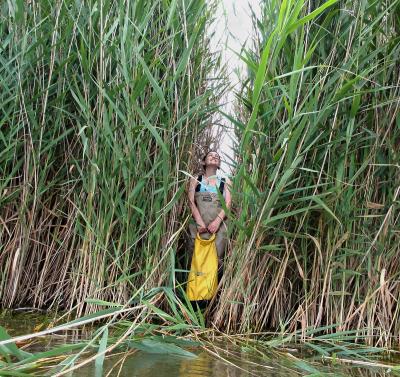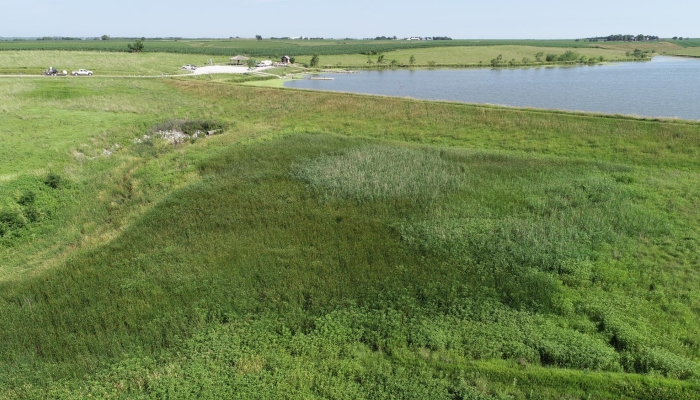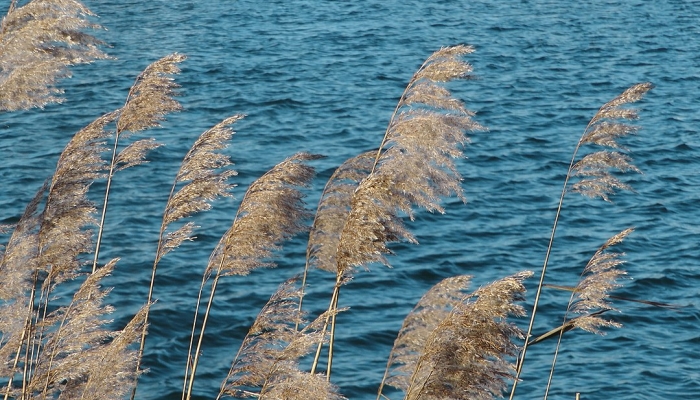Invasive species removed from Oxbow Trail
An eagle-eyed recreation enthusiast spotted the trouble first: tall, reedy plants with fluffy seed heads were proliferating on the southern edge of property at Upper Big Blue Natural Resources District’s Oxbow Trail Recreation Area (near Ulysses). The distinctive looking plants were non-native Phragmites (frag-MY-tees), an aggressive wetland grass that outcompetes native plants and displaces wildlife. This species of reed can rapidly reach up to 18 feet tall and growth is exceptionally dense.
The spread of phragmites is especially problematic at the NRD managed property, as it threatens two of the main goals of the area: human recreation and wildlife habitat. Phragmites can reduce native fish and wildlife populations by making the area uninhabitable, limiting recreation value for birdwatchers, walkers, fishers, boaters, and hunters. Phragmites creates a dense jungle of vegetation that, unchecked, will block out native vegetation while providing little or no food or shelter for most native wildlife.
The species poses another threat—fire. Phragmites grows very rapidly and each fall plant material dies back, creating large concentrations of tinder-dry vegetation that increase the potential for fast-spreading fires that can threaten surrounding property. This is a major concern for parts of Nebraska that are dealing with the impacts of drought.
Once the problem was identified, NRD staff acted quickly to remove the species at Oxbow. Due to the multiple ways Phragmites spreads (through seed production, underground rhizomes, and above ground stolons), it can be tricky to kill off completely once it gets established. Mowing or burning is generally unsuccessful in managing this species unless it is a concentrated, multiyear effort. The best way to control the species according to U.S. Fish and Wildlife is through the careful and targeted application of specific herbicides by licensed applicators.
 (Photo: Phragmites are a growing problem across the U.S. This photo of Phragmites was taken in the Great Lakes region.)
(Photo: Phragmites are a growing problem across the U.S. This photo of Phragmites was taken in the Great Lakes region.)
The NRD contracted with an applicator, who used a drone to spray the phragmites stand with an EPA approved herbicide. The drone was the perfect tool to use for this job, as it was in a hard-to-reach marshy area and it required precision application to ensure that only the phragmites were impacted, not other plants growing nearby.
The NRD staff encourages all district residents to be on the watch for this invasive species and to alert the office if you spot it growing on NRD managed properties. If you see it on your land, call your county's noxious weed office. For more information on this topic, view this resource from U.S. Fish and Wildlife.
The spread of phragmites is especially problematic at the NRD managed property, as it threatens two of the main goals of the area: human recreation and wildlife habitat. Phragmites can reduce native fish and wildlife populations by making the area uninhabitable, limiting recreation value for birdwatchers, walkers, fishers, boaters, and hunters. Phragmites creates a dense jungle of vegetation that, unchecked, will block out native vegetation while providing little or no food or shelter for most native wildlife.
The species poses another threat—fire. Phragmites grows very rapidly and each fall plant material dies back, creating large concentrations of tinder-dry vegetation that increase the potential for fast-spreading fires that can threaten surrounding property. This is a major concern for parts of Nebraska that are dealing with the impacts of drought.
Once the problem was identified, NRD staff acted quickly to remove the species at Oxbow. Due to the multiple ways Phragmites spreads (through seed production, underground rhizomes, and above ground stolons), it can be tricky to kill off completely once it gets established. Mowing or burning is generally unsuccessful in managing this species unless it is a concentrated, multiyear effort. The best way to control the species according to U.S. Fish and Wildlife is through the careful and targeted application of specific herbicides by licensed applicators.
 (Photo: Phragmites are a growing problem across the U.S. This photo of Phragmites was taken in the Great Lakes region.)
(Photo: Phragmites are a growing problem across the U.S. This photo of Phragmites was taken in the Great Lakes region.)The NRD contracted with an applicator, who used a drone to spray the phragmites stand with an EPA approved herbicide. The drone was the perfect tool to use for this job, as it was in a hard-to-reach marshy area and it required precision application to ensure that only the phragmites were impacted, not other plants growing nearby.
The NRD staff encourages all district residents to be on the watch for this invasive species and to alert the office if you spot it growing on NRD managed properties. If you see it on your land, call your county's noxious weed office. For more information on this topic, view this resource from U.S. Fish and Wildlife.


